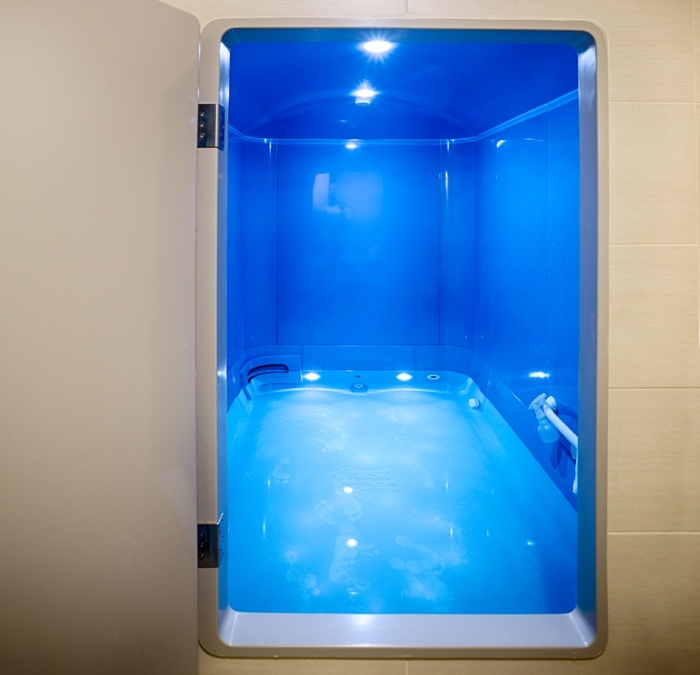Here’s what happened when I tried floating in a tank
Just Float in Pasadena is the biggest float center in the world—and the wellness trend may help people with stress, jet lag, pain, and other ailments.

Want to take your meditation practice to the next level? Just add water.
From Vancouver to New York City, luxury float centers—where the wellness-conscious commune with their psyches inside sensory deprivation chambers that are filled with several inches of body-temperature, Epsom salted water—are emerging as the next big thing in mindfulness.
And when we say big, we also mean it literally: Just Float, which recently opened in the Los Angeles suburb of Pasadena, is currently the world’s largest floating destination. If there’s any spa that can do for floating what SoulCycle did for spinning (in SoCal and beyond), it’s this one. So I had to dip a toe in.
Just Float was co-founded by self-proclaimed “serial entrepreneur” Jim Hefner, who first learned about the practice via comedian Joe Rogan (who has a float tank in his house). After his first profoundly relaxing dip at an Orange County float center two years ago, recalls Hefner, “I thought, ‘Floating needs to be everywhere—why is it not more available? Humanity is in dire need [of] this.’” (It might sound like a serious exaggeration on his part, but floating has been studied for all kinds of real health issues—more on that in a minute.)
According to Jennifer Nied, senior editor at American Spa magazine, ultra-enlightening experiences like Hefner’s are why floating has gained so much traction over the last several years. “When floating, the body is supported yet completely relaxed, and this physical relief leads to mental and emotional release to help people recover from stress,” she says. “It’s a necessity in the hyper-available digital world we live in.”

So what does floating in a tank really feel like?
What really sets Just Float apart from the handful of other floatation spas in the LA area—aside from its record 11 tanks—is its proprietary design that’s meant to help you deal with the floating’s elephant in the living room: tight spaces.
“The [float tank] can be a little intense, so we try to help transition you with the architecture,” says Hefner. “All of the shapes, colors, audio, and light were sweated over. [From the front door to the float suite], the space gets smaller and smaller, the light gets lower and lower, and then we put you in the box. All of which was intentional.” It might not work for those with major claustrophobia, but for the rest of us it’s like training wheels for tight spaces.
After you check in, you’ll take shower in private room before entering the float tank. Don’t worry about bringing a swimsuit—it’s best to totally eliminate physical distractions by floating in the nude, I was told. (It also helped to know that the chambers are powerfully sterilized four times after each session using hydrogen peroxide and UV light.)
The sound-proof, light-proof tanks, designed exclusively for Just Float, are quite roomy by floating standards—five feet wide, eight feet long, and seven feet tall. The high ceilings probably get a whole lot more people intrigued who’d otherwise panic at the idea of being enclosed in the typical coffin-style float pod for an hour. Just sayin’.
Once inside, you close the oversized “bank vault” door (it’s easy to pop it back open if you need to), hit a button to turn off the lights and music, and focus on your breathing. You’re not supposed to be surprised if you soon think you hear sounds, see vibrant visual patterns, or get a burst of creativity, all of which are commonly reported effects of floating. I definitely felt transported as the time whizzed by.
After an hour, when the lights and music gently rise again, you’ll emerge back into the world, at which point I’d recommend hitting up the post-float lounge for a tea and reacclimation before braving the freeway. (You’ll need it—the whole trippy experience feels like traveling to outer space and back.)
 Why scientists love floating
Why scientists love floating
But lest you think this is just a fancy form of hot water with a wellness scene price tag ($60, though packages with discounted sessions are available), studies have linked floating with everything from stress and pain reduction to enhanced creativity, athletic performance, and mental health (it’s being studied as a particularly powerful antidote to PTSD).
And the practice is about to undergo a whole new level of scientific scrutiny—in February 2016, Just Float is hosting the California Institute of Technology’s neuroscience department to conduct the first peer-reviewed study on floating’s brain effects using wireless EEG brain wave transmitters.“The research dealing with floating over the next two years is going to be monumental,” says Hefner. “There is enough anecdotal evidence [of floating’s benefits] that is compelling enough to make [scientists] put more money into research.”
To see some of that evidence firsthand, just flip through the communal journal in Just Float’s lounge, where guests record their experiences. As one entry states: “I entered full of noise, self-doubt, and fear; I emerged renewed and reminded of the truth.” Clearly, this destination and others are helping people stay afloat in more ways than one. —Erin Magner
Just Float, 76 N. Hudson Ave. #120, Pasadena, CA, 91101, 818-639-3572, justfloat.com.
No float centers near you? Here’s how you can create an aquatic detox ritual at home.
(Photos: @Stocksy/Branislav Jovanović; Just Float)
Sign Up for Our Daily Newsletter
Get all the latest in wellness, trends, food, fitness, beauty, and more delivered right to your inbox.
Got it, you've been added to our email list.










